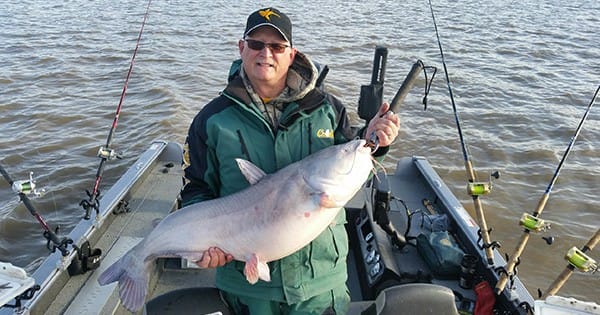
Summertime is made for inviting friends and family for a fish fry. Two delicious fish to catch day or night are crappie and catfish. These fish bite best when the current is running. Or, in a lake without current, both crappie and catfish will hold on the thermocline, a place where cool water from the bottom and the warmer top layer water meet along the edges of underwater creek and river channels, humps, drop-offs, brush and ledges.
Taking Summer Crappie Day and Night 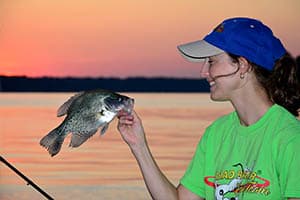
Avid crappier Jonathan Phillips of Wetumpka, Alabama, knows that summertime crappie will relate to underwater structure that can’t be spotted without a depth finder and uses these tactics when he fishes crappie tournaments all across the nation.
“I like a Humminbird Helix 10 HD side scanning and down scanning depth finder,” Phillips says.
Since Phillips generally fishes offshore in a main lake or the main part of the river where jet skiers and pleasure boaters create waves, he explains, “Instead of using multiple poles and spider rigging during the summer, I’ll fish with a single pole with either a double- or a single-minnow rig straight down to where I’ve located the crappie with my depth finder.”
He also uses maps like Navionics and Humminbird’s LakeMaster, searches for contour bottom changes and scans with his depth finder around underwater structure to know where crappie are ganged-up.
Phillips compares catching summer crappie in deep water to picking cotton. “Start at the top of the school, catch as many crappie as possible, move deeper into the cover or the ledge, and then catch the center of the crappie school to keep from spooking other crappie.”
Phillips usually has 50-100 crappie locations identified and says, “I never try to catch all the crappie on any  location.”
location.”
When he drops a buoy on top of a school, he explains that he wants his minnow, “dancing right above the crappie. I’ll tight-line with live minnows and fish larger-profile jigs, due to the big size of the spawned shad. You must keep your minnows alive with a battery-powered aerator in a cooler containing ice treated with Better Bait Systems to get rid of chlorine and the minnows’ ammonia problem.”
The amount of weight Phillips fishes depends on depth and current, primarily 1/2- to 3/4-ounce on 8-pound-test hi-vis main line with a slip sinker above a barrel swivel and 18 inches of 6-pound leader with a #1 wire crappie hook at its end. If vertical jigging, Phillips fishes a chartreuse-colored jig or a jig with a chartreuse tail, doesn’t tip his jigs with minnows and uses fish attractant.
To avoid the heaviest boat traffic from 10:00 am until 4:00 pm, he often fishes with his wife Alicia at night near deep-water boat docks with lights that attract baitfish and crappie. However, they’ve learned the best summer crappie bite often occurs from just before daylight until 10:00 am.
Crappie fishermen across the country use these methods of catching crappie as well as longline trolling with jigs and/or crankbaits, fishing small inline spinners, side-pulling hair jigs tipped with minnows, shooting docks with jigs and fishing shallow water and deep water blowdowns with minnows.
Catching Daytime Summer Catfish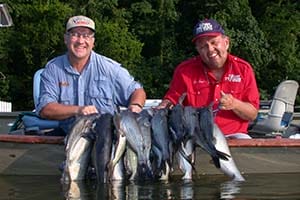
Everyone knows tailraces are productive places to catch summer catfish in the daytime. Dams are summertime catfish-catching sites, and locks offer long concrete walls leading into the lock where baitfish and catfish hold. Motor up to the lock wall, run beside the wall with a depth finder to spot baitfish and structure, kill your motor and start fishing.
Most dams have wing walls in front of their floodgates, coming from the base of the dam out into the water, with the concrete above the water extending below the water. The end of an underwater wing wall often will have a hole that’s been created due to the tremendous amount of current at the end of the wing wall when the floodgates are open, and/or water comes over the dam. Below the dam too, the underwater rock piles will yield catfish.
Catfish may hold in the slack water created when turbines run side by side, and the underwater rocks break the current, forming a slack-water groove or seam. Bumping the bottom for catfish there is very effective.
Many anglers fish for cats with abrasion-resistant 15-20-pound line and check their lines every time they catch a catfish to identify the damage done by the catfish. The sharp, bony spines on a catfish’s dorsal and pectoral fins will nick and cut line. Some catfishermen will move 10 – 12 inches up the line, pinch on a 1/2-ounce split shot, tie a #2 Eagle Claw Pattern 84 hook onto the end of the line, and fish with live threadfin shad minnows. This size hook allows you to hook the threadfin shad through the nose without killing it.
Taking Big Catfish by Day and Night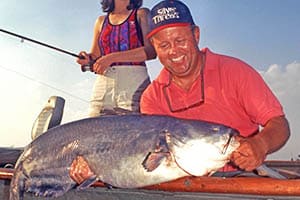
During the summer whether the current’s running or not, Phil King of Corinth, Mississippi, who’s won numerous national catfish contests, as well as participated in international catfish competitions, searches for monster sized catfish – 12–100 pounders – in holes in the bottoms of lakes and rivers by day and at night.
“I use my depth finder to locate holes in the bottom and often can spot catfish holding in front of a hole, in a hole or in a second drop-off in the hole,” King explains. “I define a hole in the bottom as a small depression that may only be 4–5 feet wide and 6–10 feet long, or it may be a deep bottom break that runs for 1/2-mile downriver.”
To fish the holes, King likes a two hook rig baited with fresh chicken livers, sometimes dipping them in red food coloring. Here’s how King rigs to fish holes. His main line is 60-65-pound test braided line with a heavy duty three-way swivel tied to it. Coming off the second eye of the three-way swivel, King ties 2 feet of 60-pound monofilament line and a No. 5/0 or a No. 8/0 circle hook. On the bend of the hook, he attaches 2-4 inches of 60-pound monofilament line and adds a second hook, since he fishes for very large catfish. Coming from the third eye of the three-way swivel, he ties 2 feet of 60-pound monofilament and attaches a 1-4-ounce lead sinker, depending on the current.
“When I go downriver to fish holes, I think about how to position my boat and how to fish those holes,” King reports. “I’ll start fishing above the hole and bump my baits back with a controlled drift, using my trolling motor, so that I can catch fish in front of the hole first. If the cats are in a feeding mode, they’ll be out of the hole and from 5–10 feet out in front of the lip of the break. If they’re not in a feeding mode, they’ll be down in the hole.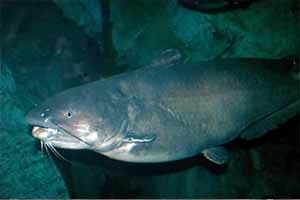
“Let your lead and your bait drift back about 40 to 60 feet from the boat as you bump the bottom and while you’re holding your boat against the current with your trolling motor. You want to feel your lead tag the bottom slightly as you walk the bait back to the edge of the hole and allow the lead and the bait to fall into the hole. Continue to bump the lead back along the bottom of the hole.”
To catch the very big cats, remain silent in the boat anywhere around the hole. King has discovered that the bigger a catfish is, the more sensitive it is to sound. Then you can catch, photograph and release a monster catfish.
*** Be sure to check the regulations in your state about the sizes of catfish you can keep.
Written by John E. Phillips



